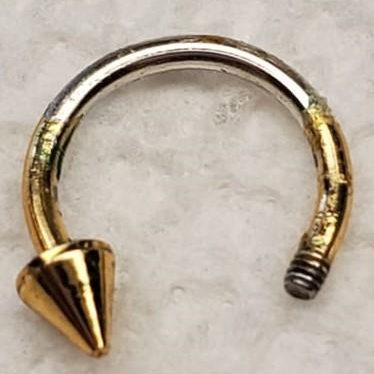Black metals: are they safe?
In the piercing industry, many people are interested by the aesthetics of black jewelry. They give an edgy and daring look as opposed to the usual jewelry colors worn in piercings. Unlike popular beliefs, the majority of black jewelry available on the market are not made of a quality that should be used in fresh or healed piercings. In this blog, we will be covering three types of black metals: PVD coated, niobium and black rhodium.

Niobium Seam Ring from LeRoi
The first type of black metal on the list is the most common in the piercing industry: it is black PVD jewelry. The first thing that is important to know is what does PVD mean. To make it simple, it’s an acronym for Physical Vapor Deposition and the process consists of applying thin layers to a piece of jewelry via a vacuum deposition process. These layers are generally applied on a type of metal, more often than not on stainless steel. The problem is that PVD coating is not as flexible if it needs to be bent and thus can flake on the long run causing irritation. Moreover, stainless steel being exposed to the wearing surface may cause allergic reaction in certain individuals due to its composure being mixed with nickel. Considering that there are no current ways of using this process in a safe way to make body jewelry, black PVD coating must be avoided; they are poor quality and low durability jewelry, whether they’re being used for a fresh or healed piercing. PVD coting can be found in all colors (black, gold, blue…).

Gold color PVD jewelry which has been worn for some time- you can see the PVD layer flaking
The second type of metal that might be a little less known by the general public is Niobium. Niobium is elemental, which means nothing is added to the metal. It is very similar to titanium which is why it is biocompatible: even though it is a foreign object, the body tolerates it well and because it is elemental, there is no nickel in it either. Just like titanium, niobium can be anodized and can reach a shiny black finish. You can differentiate black PVD and Niobium simply because the shade isn’t the same. Niobium has more of a mirror finish as where PVD coating is more of a pitch-black color. It is a much safer and better quality of body jewelry and is often going to be recommended in professional piercing studios even though it might be a little more expensive.

@piercing_by_danny on Instagram, Member of the APP
Lastly, there exists Black Rhodium jewelry. Black Rhodium is a plating which is and should only be used on 14k to 18k solid gold. However, just like anodization, it’s a finish that may fade in time depending on the wearer. It also has to stay at the surface and not within the wearable space, which means Black Rhodium will mostly be used for jewelry ends and not for a complete jewelry, such as a circular barbell or a labret post.

@anne.piercer at Studio Zen Tattoo, Member of the APP
In conclusion, consult your professional piercer about black jewelry and don’t forget that Niobium is definitely the safest option for a long-time wear.